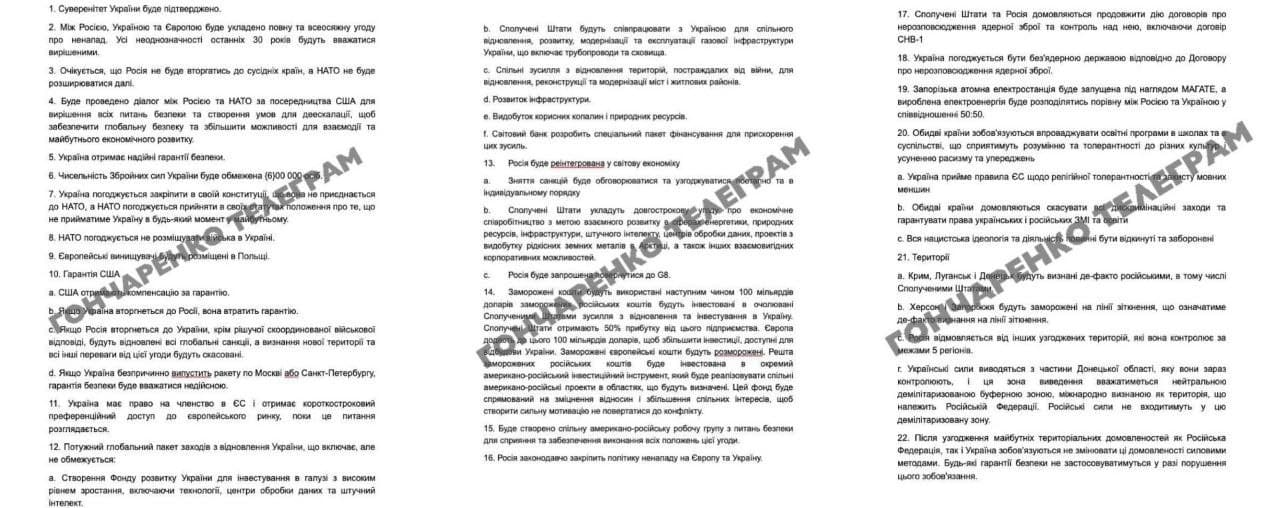U.S. Proposes 28-Point Peace Plan to End Ukraine-Russia War
In a significant diplomatic development, a Ukrainian source has revealed details of a proposed 28-point peace plan aimed at resolving the ongoing conflict between Ukraine and Russia. This plan, which has been put forth by the United States, outlines a comprehensive framework for peace and security in the region, addressing key issues that have persisted for over three decades.
Key Details
The peace plan includes several critical points, starting with the affirmation of Ukraine"s sovereignty. This foundational aspect emphasizes the recognition of Ukraine as an independent nation, a crucial element in any negotiations aimed at ending hostilities.
One of the central tenets of the proposal is the establishment of a full and comprehensive non-aggression agreement between Russia, Ukraine, and European nations. This agreement seeks to resolve ambiguities that have arisen over the past 30 years, aiming for a stable and peaceful coexistence in Eastern Europe.
Furthermore, the plan anticipates that Russia will refrain from invading neighboring countries, while NATO will not expand its membership further. This mutual understanding is designed to alleviate security concerns on both sides and foster a more cooperative environment.
To facilitate dialogue, the plan calls for discussions between Russia and NATO, mediated by the United States. This dialogue aims to address security issues, promote de-escalation, and enhance global security, ultimately creating opportunities for future economic development.
In terms of military arrangements, Ukraine is expected to receive reliable security guarantees. However, the size of the Ukrainian Armed Forces will be limited to 600,000 personnel, a stipulation intended to balance military capabilities in the region.
Additionally, Ukraine will enshrine in its constitution a commitment not to join NATO, with NATO reciprocating by adopting provisions that prevent Ukraine"s future membership. This mutual agreement aims to reduce tensions and clarify the military alignments of the involved parties.
The plan also specifies that NATO will not station troops in Ukraine, while European fighter jets will be positioned in Poland to bolster regional security.
Regarding U.S. involvement, the plan outlines several conditions for security guarantees. The United States will receive compensation for providing these guarantees, and if Ukraine were to invade Russia, it would lose this guarantee. Conversely, if Russia invades Ukraine, a coordinated military response will be enacted, alongside the reinstatement of global sanctions and the revocation of any territorial recognition gained through aggression.
Ukraine is granted the right to pursue European Union membership and will receive short-term preferential access to the European market during the consideration of its membership application.
The proposal also includes a robust global package for the reconstruction of Ukraine. This package encompasses the creation of a Ukraine Development Fund aimed at investing in high-growth sectors such as technology, data centers, and artificial intelligence. The United States is expected to collaborate with Ukraine on the modernization and operation of its gas infrastructure, including pipelines and storage facilities.
Joint efforts will focus on restoring war-affected areas, including the reconstruction of cities and residential areas, infrastructure development, and the extraction of minerals and natural resources. The World Bank is tasked with developing a special financing package to expedite these reconstruction efforts.
On the economic front, the plan proposes the gradual and individual lifting of sanctions against Russia, contingent on its compliance with the peace agreement. A long-term economic cooperation agreement between the United States and Russia is also envisioned, focusing on mutual development in various sectors, including energy and infrastructure. Additionally, Russia may be invited to rejoin the G8, signaling a potential reintegration into the global economy.
Finally, the plan addresses the use of frozen assets, proposing that $100 billion of frozen Russian assets be invested in U.S.-led efforts to rebuild Ukraine, with the United States receiving 50% of the profits. Europe is expected to contribute an additional $100 billion to enhance reconstruction funds, while frozen European assets will be unfrozen. The remaining frozen Russian assets will be allocated to a separate U.S.-Russian investment vehicle aimed at fostering joint projects and strengthening bilateral relations.
Background
This peace proposal comes amid ongoing tensions and hostilities stemming from the conflict that began in 2014, following Russia"s annexation of Crimea and the subsequent war in Eastern Ukraine. The international community has been actively seeking a resolution to restore peace and stability in the region.
What"s Next
The proposed peace plan represents a significant step toward de-escalating the conflict and fostering cooperation between Russia, Ukraine, and NATO. The success of this initiative will depend on the willingness of all parties to engage in constructive dialogue and adhere to the outlined agreements. As the situation evolves, further developments are expected, potentially

![[Video] Trump considered bombing Iran to prevent Israeli nuclear threat, says former CIA officer](/_next/image?url=%2Fapi%2Fimage%2Fthumbnails%2Fthumbnail-1763700693027-c1bzwj-thumbnail.jpg&w=3840&q=75)
![[Video] Former CIA Officer: Israeli policy targets entire city blocks to kill individuals](/_next/image?url=%2Fapi%2Fimage%2Fthumbnails%2Fthumbnail-1763700675052-6im6kr-thumbnail.jpg&w=3840&q=75)
![[Video] Former CIA Officer: Israelis recruited Afghan refugees in Iran](/_next/image?url=%2Fapi%2Fimage%2Fthumbnails%2Fthumbnail-1763700658825-6rt46g-thumbnail.jpg&w=3840&q=75)

![[Video] Former CIA Officer: Agency can remotely take over cars to cause crashes](/_next/image?url=%2Fapi%2Fimage%2Fthumbnails%2Fthumbnail-1763700645146-5ij3c8-thumbnail.jpg&w=3840&q=75)